Enjoying music at home has never been easier with the current wide array of options, from Bluetooth speakers to separate hi-fi systems and headphones. Wireless speakers have grown in importance over the past decade or so, with all kinds and sizes on offer. Bluesound features a complete range, with three speaker formats, a sound bar and a subwoofer, as well as a streamer, a connected amplifier and a server.
The Bluesound Pulse Sub+ wirelessly connects to any other element in the range with specific prominence for low frequencies. It replaces the first Pulse Sub, taking up the multi-destination aesthetic by improving on its most important points. Speaker diameter has increased from 16.5 to 20 cm, with added power as well. However, the connection has been simplified. The first Pulse Sub offered a series of outlets that allowed it to be used stand-alone, unconnected, with devices from any manufacturer. All of that is gone, as are the audio settings, available physically on the first Pulse Sub but now only available in the mobile app for the new Pulse Sub+.
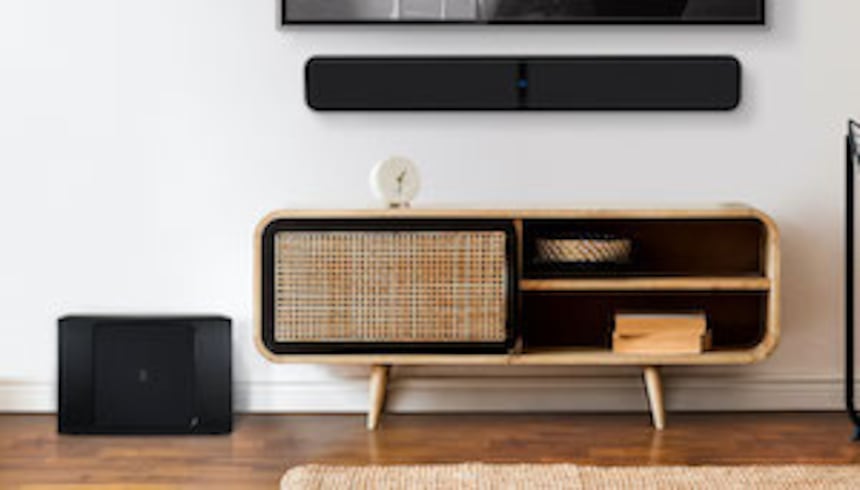
Features
● Price: €849
● Wireless subwoofer
● Speaker: 200 mm
● Power: 150 Watts in Class D
● Bandwidth: 22-150 Hz
● Connectivity: WiFi ac, Ethernet, 1x Mono Low/Line Level Input, USB port for maintenance
● Compatibility with all Bluesound Pulse 2i devices
Overview of the Pulse Sub+
The Pulse Sub+ features a design that is quite different from the cubic format of most subwoofers. Bluesound chose a flat format, perhaps for technical reasons, but mainly for installation versatility. The sides are cut off from the rear, thereby giving it a trapezoidal shape when seen from above.
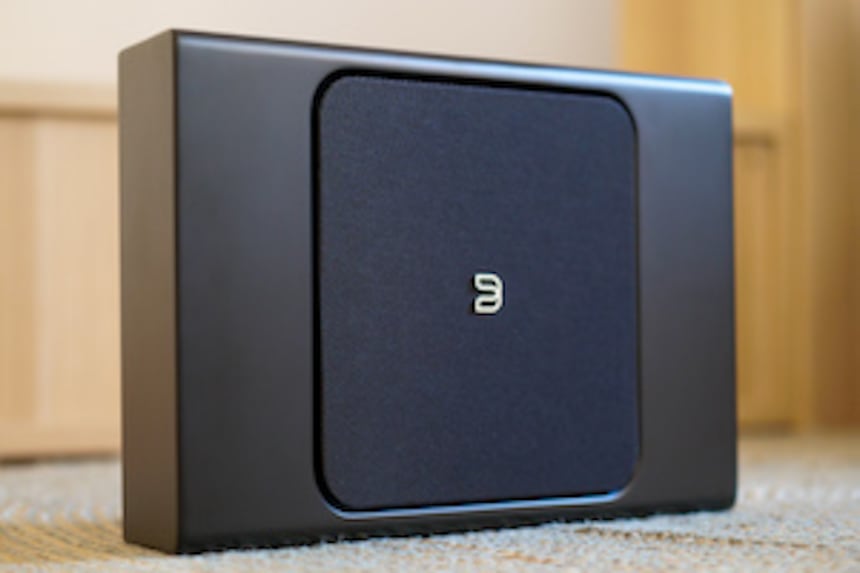
The bass speaker is located on the front panel, positioned in a recess to accommodate the magnetic grid without protruding once in place. On the right side, Bluesound has placed three function keys surrounded by LED lighting that can be deactivated via the app.
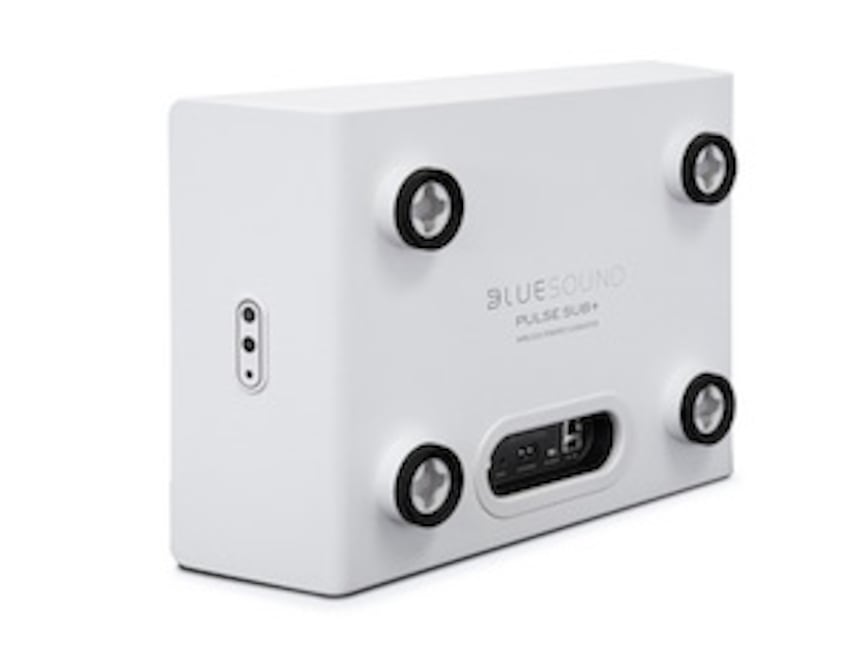
The rear side reveals four large rubberised feet. In the centre, a cross indicates a wall mounting system. The feet are there both to cushion the box once installed, or to allow the cables connected to the rear to pass through. A small cavity at the bottom features the few available sockets.
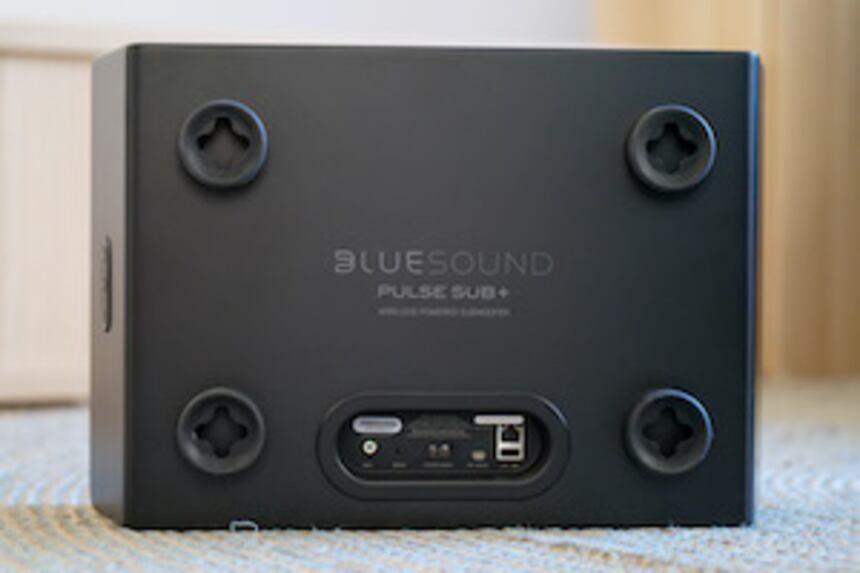
The unit’s finish is perfect, with no visible screws or assemblies. The sturdy device is covered in matte paint. You can choose between black or white, with a removable protective grille in light grey or black. However, we have a black model, and we can tell you that this beautiful finish is sensitive to fingerprints. They are easy to clean, without any marks or scratches, but you will have to take good care of this device.
Operation of the Pulse Sub+
The Pulse Sub+ has no buttons, with everything going through the BluOS mobile app. However, before you can add the subwoofer, you first need at least one previously installed Bluesound speaker, as the subwoofer is necessarily associated with another element which it complements in reproducing low frequencies.
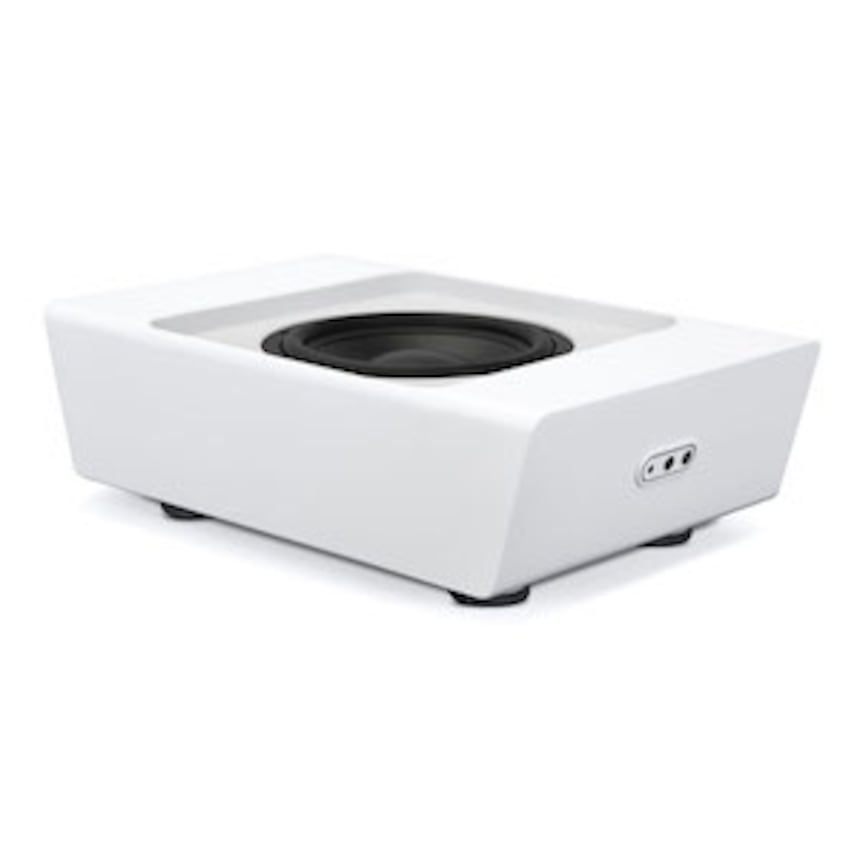
Using the app, you will choose to add a new device. A link appears at the very bottom of the screen, offering to specifically install a subwoofer. When you select this option, installing the subwoofer requires choosing the WiFi network and entering the password. A few seconds later, the subwoofer is linked to the system, which then asks which speaker to link to the subwoofer.
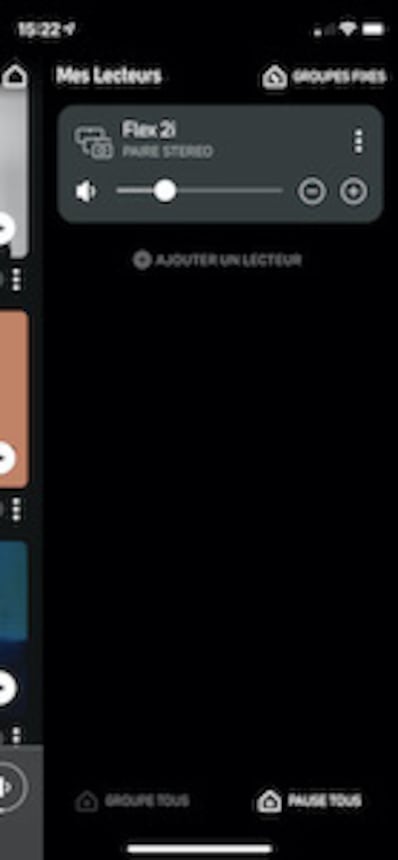
The sound will then be shared by the subwoofer and the speaker(s); however, these are the default settings. Users can easily access and control volume, crossover, and phase adjustment via the BluOS Controller app available for iPhone and Android devices. The listener can adjust the right settings if the default ones don’t make the grade. You can also set the bass and treble, the former affecting the sound reproduction of the subwoofer. Once those operations are completed, you can forget about the unit, with no further need to adjust the settings. The unit is synchronised: when you raise the speaker volume, the subwoofer volume increases accordingly.
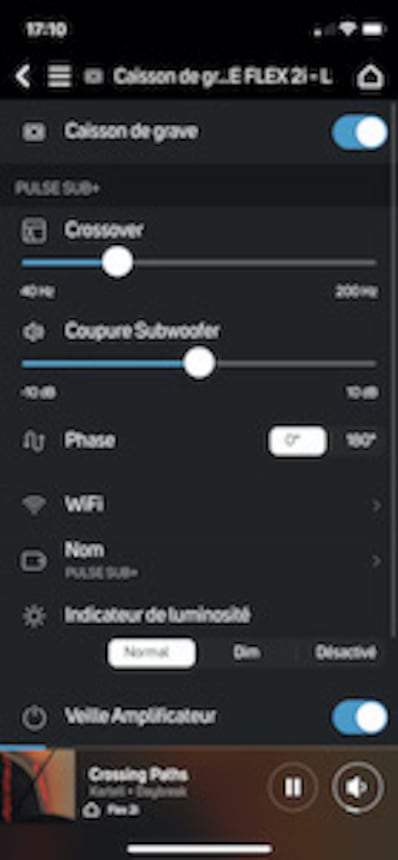
We conducted a number of tests and realised vertical was the best position. We did not drill into the wall to install the unit, placing it at the foot of the wall, with all four feet resting against it, an unexpected setup given the device does not have feet on its lower edge. We therefore placed it on a non-slip mat. When vertical, the Pulse Sub+ must be fixed to the wall on using the support provided in the packaging. Otherwise, placed flat on the floor, it can easily disappear under a piece of furniture or a sofa, which didn't work as well in our listening room.
Listening session
We obviously focused on reproducing bass frequencies, while taking into account the connection between the subwoofer and the speakers. The track Onde Sensuelle by -M- is already over 20 years old, yet still boasts excellent production with a fine balance and especially tight bass. It’s one of the tracks we return to again and again. The Pulse Sub+ is perfectly comfortable delivering this kind of dynamic low frequency. The device delivers bass you would expect from a compact cabinet, without any unwanted noise, even at sustained levels, with impact and volume suggesting the Sub+ boasts a much larger volume payload than it actually has.
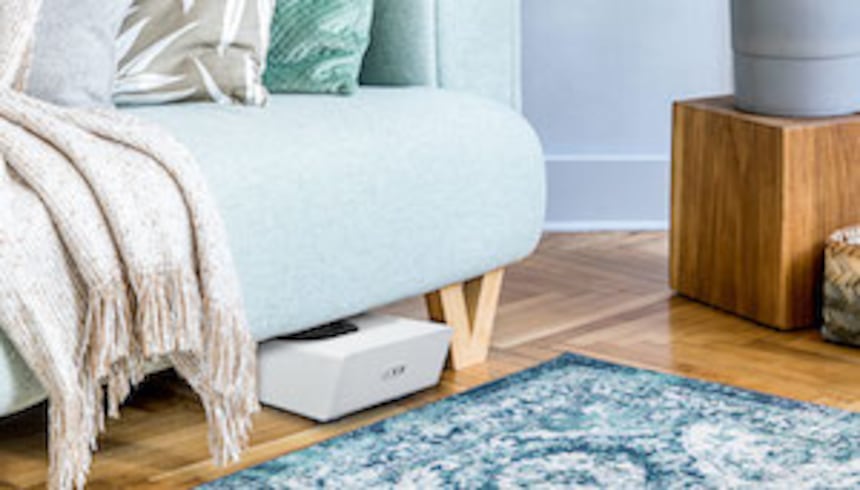
On The Truth, the latest album by rapper James The Prophet, bass is everything. With that deep, layered bass underpinning the nu-soul sounds of this album, you need a powerhouse system to fully experience it. That’s precisely what the Pulse Sub+ delivered. Although we feel it is somewhat limited in sub-bass frequencies (we don’t begrudge it, given its understated side), it offers hi-fi reproduction with sharp detail and refinement throughout the entire extent of the spectrum in its range. Vibrant, growly, punchy, the Sub+ makes all the difference required.
We couldn’t resist pushing the unit to its limits with our usual reference track, North Star by Tale of Us. We are deep into the domain of heavy bass and sub-bass, with an album that leaves little hope for speakers and subwoofers that front hard or try to delude the listener. And the Sub+ came through with flying colours. Subjectively speaking, it descends into those registers without leaving anything lacking. Plus, it does so at completely comfortable sound levels without breaking a sweat or running out of steam. We stopped turning the potentiometer, but the device had plenty left under the hood to make the ground quake.
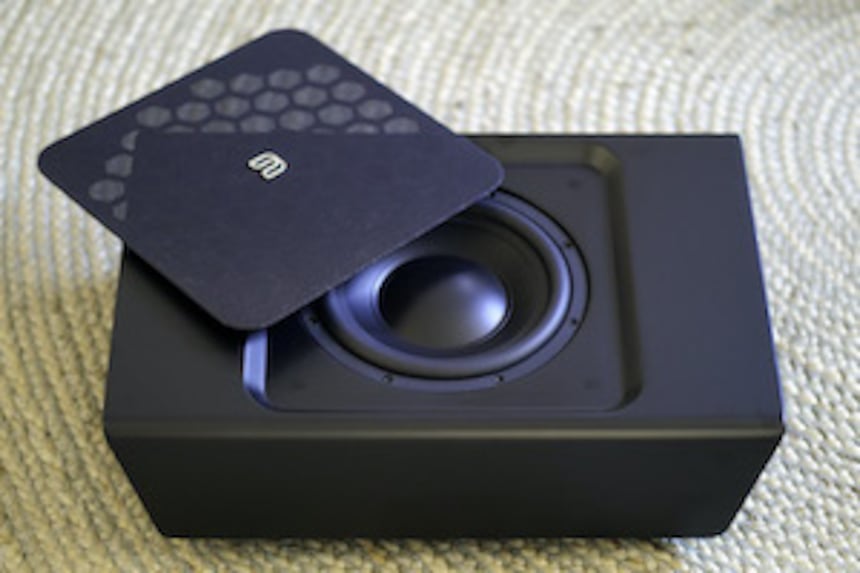
With a pair of Bluesound Pulse Flex 2i speakers, the smallest in the range, it must be said that this is not a plug-and-play arrangement. It will take a little time to get the correct connection between the subwoofer and the speakers of the 2.1, depending on how they are set up, and the parameters of the listening room. Since the Flex 2i are small speakers, we set the cutoff frequency at 100 Hz, rather than the default 40 Hz, and raised the subwoofer level. The 180° phase also yielded a much better result. All this is to say that you have to experiment, trust your ears and your tastes, or possibly take measurements with a microphone to get the perfect setting.
Pros:
Dynamic bass without lag
Excellent capacities in the lowest frequencies
Substantial sound levels
Wireless makes location a snap
Multiple installation possibilities
Complete settings via the app
Cons:
Material sensitive to fingerprints
Conclusion
The Pulse Sub+ is aimed primarily at owners of Bluesound-connected systems and will complement a single speaker, a stereo pair or a soundbar from the Pulse range – all without having to physically connect them, thanks to its network connectivity. That allows the listener to easily find the perfect location for the unit, especially with its multiple installation options: in plain view, hidden under furniture or fixed to the wall. The settings offered by the BluOS mobile app may be a little off-putting at first glance, but you’ll have everything you need to set up the ideal combination thanks to the precise settings. Finally, despite its compact size, the Bluesound subwoofer delivers quality hi-fi bass, with nuance throughout the entire range of frequencies it can reproduce. It plays at a high level, adapting to large or small rooms. The Pulse Sub+ really is an exemplary subwoofer.
